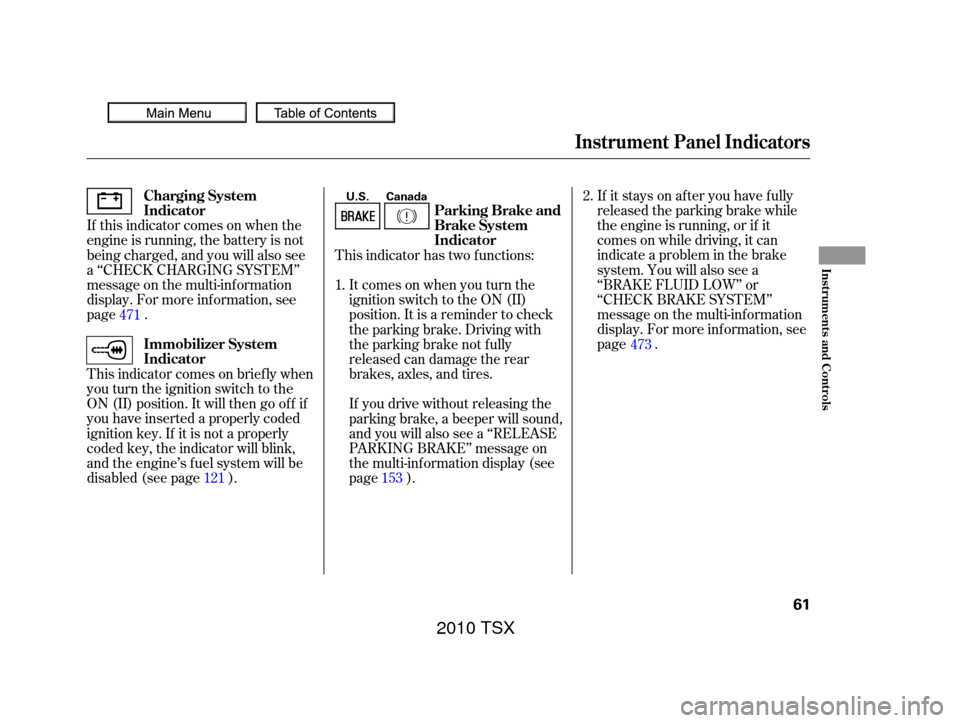Engine Acura TSX 2010 Owner's Manual
[x] Cancel search | Manufacturer: ACURA, Model Year: 2010, Model line: TSX, Model: Acura TSX 2010Pages: 524, PDF Size: 12.34 MB
Page 4 of 524

(f luid capacities and tire pressures)
(main controls)
(seat belts, SRS, and child protection)
(indicators, gauges, multi-inf ormation display, dashboard, and steering column)
( )
(fuel, vehicle break-in, and cargo loading)
(engine and transmission operation) (minder, f luid checking, minor services, and vehicle storage) (f lat tire, jump starting, overheating, and f uses)
(vehicle specif ications, tires, and emissions controls) (warranty and contact inf ormation)
(how to order)
climate control, audio, steering wheel, security, cruise control, HomeLink , and other convenience items
Contents
........................................................................\
........................................................................
Index .I
Service Inf ormation Summary ........................................................................\
.......................
Your Vehicle at a Glance .3
............................................................
Driver and Passenger Saf ety .5
.......
Instruments and Controls .57
..............
Features .165
.......................................................................
Bef ore Driving .345
........................................................................\
.................
Driving .365
.................................................
Maintenance .401
........................................
T aking Care of the Unexpected .457
..............................................
T echnical Inf ormation .485
.......................
Warranty and Client Relations (U.S. and Canada only) .505
........................................................................\
..........
A uthorized Manuals (U.S. only) .509
1
Owner's Identification Form
00X31-TL1-6100
\251 2009 American Honda Motor Co., Inc. - All Rights Reserved 2010 TSX
2010 TSX
Page 5 of 524

A convenient ref erence to the
sections in this manual.
A quick ref erence to the main
controls in your vehicle.ID numbers, dimensions, capacities,
and technical information.
Important inf ormation about the
proper use and care of your vehicle’s
seat belts, an overview of the
supplemental restraint system, and
valuable inf ormation on how to
protect children with child restraints.
Explains the purpose of each
instrument panel indicator and gauge,
the multi-information display, and
how to use the controls on the
dashboard and steering column.
How to operate the climate control
system, the audio system, and other convenience f eatures.
This section covers several problems
motorists sometimes experience,
and details how to handle them. The maintenance minder shows you
when you need to take your vehicle
to the dealer for maintenance service.
There is also a list of things to check
and instructions on how to check
them. The proper way to start the engine,
shif t the transmission, and park; plus
what you need to know if you’re
planning to tow a trailer. What gasoline to use, how to break-
in your new vehicle, and how to load
luggage and other cargo.
A summary of the warranties
covering your new vehicle, and how
to contact us for any reason. Refer to
your warranty manual f or detailed
inf ormation.
How to order manuals and other
technical literature.
A summary of the inf ormation you
need when you pull up to the f uel
pump.
Contents
Your Vehicle at a Glance
Driver and Passenger Saf ety
Instruments and Controls
T echnical Inf ormation
T aking Care of the Unexpected Maintenance Driving Bef ore Driving
Features Warranty and Client Relations
(U.S. and Canada only)
Authorized Manuals
(U.S. only)
Index
Service Inf ormation Summary
Overview of Contents
2
2010 TSX
Page 20 of 524

If you are pregnant, the best way to
protect yourself and your unborn
child when driving or riding in a
vehicle is to always wear a seat belt,
and keep the lap part of the belt as
low as possible across the hips.
In addition, an occupant who is out of
position in the f ront seat can be
seriously or f atally injured in a crash
by striking interior parts of the
vehicle or being struck by an
inflating front airbag.
Sitting improperly can increase the
chance of injury during a crash. For
example, if an occupant slouches,
lies down, turns sideways, sits
forward, leans forward or sideways,
or puts one or both f eet up, the
chance of injury during a crash is
greatly increased. After all occupants have adjusted
their seats and head restraints, and
put on their seat belts, it is very
important that they continue to sit
upright, well back in their seats, with
their feet on the floor, until the
vehicle is safely parked and the
engine is of f .
CONT INUED
Protecting A dults and Teens
Advice f or Pregnant Women
Maintain a Proper Sitting
Position
6.
Driver and Passenger Saf ety
17
Sitting improperly or out of
position can result in serious
injury or death in a crash.
Always sit upright, well back in
the seat, with your feet on the
floor.
2010 TSX
Page 35 of 524

If the indicator comes on at any
other time, or does not come on at all,
you should have the system checked
by your dealer. For example:If the SRS indicator does not come
on after you turn the ignition
switch to the ON (II) position.
If the indicator stays on after the
engine starts.
If the indicator comes on or
flashesonandoff whileyoudrive. This indicator alerts you that the
passenger’s side airbag has been
automatically shut off. It does
mean there is a problem with your
side airbags.
When you turn the ignition switch to
the ON (II) position, the indicator
should come on brief ly and then go
out(seepage ).Ifitdoesn’tcome
on, stays on, or comes on while
driving without a passenger in the
f ront seat, have the system checked.
You will also see a ‘‘CHECK
AIRBAG SYSTEM’’ message on the
multi-inf ormation display. You will also see a ‘‘PASSENGER
SIDE AIRBAG OFF’’ message on the
multi-inf ormation display.
If you see any of these indications,
the airbags and seat belt tensioners
may not work properly when you
need them. 62
Additional Inf ormation About Your Airbags
How the Side
Airbag Of f
Indicator Works
not
32
Canada
U.S.
Ignoring the SRS indicator can
result in serious injury or death
if the airbag systems or
tensioners do not work properly.
Have your vehicle checked by a
dealer as soon as possible if
the SRS indicator alerts you to
a possible problem.
2010 TSX
Page 58 of 524

Your vehicle’s exhaust contains
carbon monoxide gas. Carbon
monoxide should not enter the
vehicle in normal driving if you
maintain your vehicle properly and
f ollow the inf ormation on this page.High levels of carbon monoxide can
collect rapidly in enclosed areas,
such as a garage. Do not run the
engine with the garage door closed.
Even with the door open, run the
engine only long enough to move the
vehicle out of the garage.
Have the exhaust system inspected
f or leaks whenever:
With the trunk open, airf low can pull
exhaust gas into your vehicle’s
interior and create a hazardous
condition. If you must drive with the
trunk open, open all the windows and
set the climate control system as
shown below.
If you must sit in your parked vehicle
with the engine running, even in an
unconfined area, adjust the climate
control system as f ollows:
The vehicle is raised f or an oil
change.
You notice a change in the sound
of the exhaust.
The vehicle was in a collision that
may have damaged the underside. Select the f resh air mode.
Select the mode.
Set the f an speed to high.
Set the temperature control to a
comfortable setting.
1.
2.
3.
4.
Carbon Monoxide Hazard
Driver and Passenger Saf ety
55
Carbon monoxide gas is toxic.
Breathing it can cause
unconsciousness and even kill
you.
Avoid any enclosed areas or
activities that expose you to
carbon monoxide.
2010 TSX
Page 63 of 524

The instrument panel has many
indicators to give you important
inf ormation about your vehicle.If your f ront passenger does not
f asten their seat belt, the indicator
comes on about 6 seconds af ter the
ignition switch is turned to the ON
(II) position.
This indicator comes on when you
turn the ignition switch to the ON
(II) position. It reminds you and your
passengers to f asten your seat belts.
A beeper also sounds if you have not
f astened your seat belt.
You will also see a ‘‘FASTEN SEAT
BELT’’ message on the multi-
inf ormation display.
If you turn the ignition switch to the
ON (II) position bef ore f astening
your seat belt, the beeper sounds
and the indicator f lashes. If you do
notfastenyourseatbeltbeforethe
beeper stops, the indicator stops
f lashing but remains on. You will also see a ‘‘CHECK
EMISSION SYSTEM’’ message on
the multi-information display. For
more information, see page .
If either of you do not f asten your
seat belt while driving, the beeper
will sound and the indicator will f lash
again at regular intervals, and you
will see a ‘‘FASTEN SEAT BELT’’ or
‘‘FASTEN PASSENGER SEAT
BELT’’ message on the multi-
inf ormation display. For more
inf ormation, see page . The engine can be severely damaged
if this indicator f lashes or stays on
when the engine is running, and you
will see a ‘‘CHECK ENGINE OIL
LEVEL’’ message on the multi-
inf ormation display. For more
inf ormation, see page .
19
471472
Instrument Panel Indicators
Seat Belt Reminder
Indicator
Malf unction Indicator
Lamp
L ow Oil Pressure
Indicator
60
2010 TSX
Page 64 of 524

If it stays on after you have fully
released the parking brake while
the engine is running, or if it
comes on while driving, it can
indicate a problem in the brake
system. You will also see a
‘‘BRAKE FLUID LOW’’ or
‘‘CHECK BRAKE SYSTEM’’
message on the multi-inf ormation
display. For more inf ormation, see
page .
If this indicator comes on when the
engine is running, the battery is not
being charged, and you will also see
a ‘‘CHECK CHARGING SYSTEM’’
message on the multi-inf ormation
display. For more inf ormation, see
page .
This indicator comes on brief ly when
you turn the ignition switch to the
ON (II) position. It will then go of f if
you have inserted a properly coded
ignition key. If it is not a properly
coded key, the indicator will blink,
and the engine’s f uel system will be
disabled (see page ). This indicator has two f unctions:
Itcomesonwhenyouturnthe
ignition switch to the ON (II)
position. It is a reminder to check
the parking brake. Driving with
the parking brake not f ully
released can damage the rear
brakes, axles, and tires.
If you drive without releasing the
parking brake, a beeper will sound,
and you will also see a ‘‘RELEASE
PARKING BRAKE’’ message on
the multi-information display (see
page ).
1.
2.
471 473
121 153
Instrument Panel Indicators
Charging System
Indicator
Immobilizer System
Indicator Parking Brake and
Brake System
Indicator
Inst rument s and Cont rols
61
U.S. Canada
2010 TSX
Page 68 of 524

This indicator normally comes on
when you turn the ignition switch to
the ON (II) position and goes of f
af ter the engine starts. If it comes on
at any other time, there is a problem
in the electric power steering system.
If this happens, stop the vehicle in a
saf e place and turn of f the engine.
Reset the system by restarting the
engine. The indicator will stay on,
but should go of f af ter driving a
short distance. If it does not go of f ,
or comes back on again while driving,
take the vehicle to your dealer to
have it checked. With the indicator
on, the EPS may be turned of f ,
making the vehicle harder to steer.If you turn the steering wheel to the
f ull lef t or right position repeatedly
while stopping or driving at very low
speed, you may f eel slightly harder
steering in order to prevent damage
to the steering box caused by
overheating.
This indicator comes on red if any
door or the trunk lid is not closed
tightly.
You will also see a corresponding
indicator(s) on the multi-information
display to indicate which door and/
or the trunk is not closed tightly (see
page ).
You will also see a ‘‘CHECK POWER
STEERING SYSTEM’’ message on
the multi-information display.
11
Instrument Panel Indicators
Electric Power Steering
(EPS) Indicator Door/T runk Open
Indicator
Inst rument s and Cont rols
65
2010 TSX
Page 69 of 524

This indicator reminds you that the
exterior lights are on. It comes on
when the light switch is in either theor position. If you turn the
ignition switch to the ACCESSORY
(I) or the LOCK (0) position without
turning of f the light switch, this
indicator will remain on. A reminder
chime will also sound when you open
the driver’s door. This indicator comes on with the
high beam headlights. For more
inf ormation, see page .
This indicator also comes on with
reduced brightness when the
daytime running lights (DRL) are on
(see page ).
This indicator comes on when you
turn on the f og lights. For more
inf ormation, see page .This indicator comes on when you
turn on the cruise control system by
pressing the CRUISE button on the
steering wheel (see page ).
This indicator comes on when you
set the cruise control. See page
f or inf ormation on operating the
cruise control.
This indicator will also come on
when the light switch is in AUTO
and the lights turn on automatically. 115111
114 298
298
If equipped
All models except Canadian TSX with
4-cylinder engine
Instrument Panel Indicators
L ights On Indicator High Beam Indicator
Fog L ight Indicator Cruise Main Indicator
Cruise Control Indicator
66
2010 TSX
Page 71 of 524

This shows how much f uel you
have. It may show slightly more
or less than the actual amount.
The needle returns to the
bottom after you turn off the
ignition.
Gauges
Fuel Gauge
68
SPEEDOMETER
TEMPERATURE
GAUGE
U.S. model is shown. TACHOMETER
FUEL GAUGE
MULTI-INFORMATION
DISPLAY
Avoid driving with an extremely low
f uel level. Running out of f uel could
cause the engine to misf ire, damaging
the catalytic converter.
2010 TSX